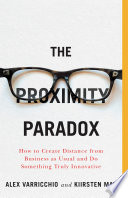

The book begins by delving into the concept of proximity and how it shapes our relationships. Proximity, in this context, refers not only to physical closeness but also emotional and psychological closeness. The author argues that in a world where technology allows us to connect with anyone, anywhere, the paradox lies in the fact that we often feel more isolated. The book explores how our digital interactions can create a false sense of closeness while neglecting the importance of meaningful, face-to-face relationships. It emphasizes that understanding the nuances of proximity can enhance our personal and professional lives by fostering deeper connections.
Continue readingIn this section, the author examines the role of digital communication in shaping our interactions. While technology has made it easier to communicate, it has also led to misunderstandings and a lack of emotional depth in conversations. The book discusses the limitations of text-based communication and how it can hinder our ability to convey empathy and understanding. By analyzing various communication styles, the author encourages readers to be more mindful of how they engage with others, advocating for a balanced approach that incorporates both digital and in-person interactions.
Continue readingThe author emphasizes the importance of authenticity in building connections. In a world dominated by social media, where people often present curated versions of themselves, the book argues that true connection requires vulnerability and honesty. It provides practical strategies for fostering authentic relationships, such as active listening, showing genuine interest in others, and being open about one’s own experiences. By cultivating authenticity, individuals can create deeper bonds that transcend superficial interactions and lead to more fulfilling relationships.
Continue readingNetworking is a crucial aspect of professional success, and this section explores how proximity influences networking opportunities. The author discusses the concept of 'weak ties' and how they can lead to valuable connections. However, he also highlights the importance of nurturing 'strong ties'—close relationships that provide support and trust. The book offers insights into how to strategically leverage both types of ties to enhance one’s career, emphasizing that proximity can be a powerful tool in expanding one’s professional network.
Continue readingThe book argues for a balanced approach to interactions in the digital age. While acknowledging the benefits of virtual communication, the author stresses the importance of maintaining physical interactions to foster genuine connections. This section provides guidelines for integrating both forms of communication into daily life, suggesting that readers prioritize in-person meetings, social gatherings, and community involvement. By finding the right balance, individuals can enhance their relationships and overall well-being.
Continue readingThe psychological implications of proximity are explored in this section, focusing on how our environments influence our mental health and relationships. The author discusses concepts such as social isolation, loneliness, and the impact of urban living on our connections. By understanding the psychological effects of proximity, readers can become more aware of their own needs for connection and community. The book encourages individuals to create environments that foster social interactions and emotional well-being.
Continue readingFinally, the author emphasizes the importance of creating a sense of community despite the challenges posed by digital communication. This section provides actionable strategies for building community, such as participating in local events, joining interest-based groups, and engaging in volunteer work. The book argues that fostering a sense of belonging is essential for personal fulfillment and that proximity—both physical and emotional—plays a critical role in creating supportive communities.
Continue reading